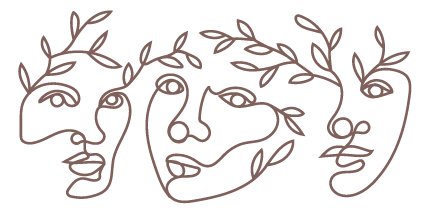Natacha Martins: An Artist's Portrait
Natacha Martins in Lepizig Studio, Summer 2020
Natacha Martins is a Portuguese artist currently living and working in Leipzig, Germany. Mainly working in oil, but also charcoal, pencil and multi-media, Natacha’s practice evolves as she changes environment and space, and is heavily influenced by her surroundings. She moved to Germany in 2019 to pursue her career as an artist, taking part in the PILOTENKUECHE International Art Program. She has now been a Leipzig resident for just over a year. As she establishes roots in this painter’s city, her work and practice continue to grow and evolve.
Natacha’s art is almost painfully human. Her impulsive mark making captures the struggles and the extremes of the human experience. Figures appear as if emerging from smoke, and twist, almost dancing, across any surface she embellishes. Her portrayals of herself are powerful in their honesty and raw depictions of the human body. There is a sometimes ominous quality to Natacha’s choice of deep and rich blues and reds which is then coupled with contorting figures and grimacing faces. As a contrast, plants and nature are points of relief and brightness in her work. There appears no struggle between nature and man but a synthesis and balance; they seem to grow into each other. In an ongoing project called Bildschirm Der Stunden (Screen Of Hours) Natacha presents the concept of the body as a garden and the garden as a body. Each ‘body-garden’, as she calls them, is unique, being individually ‘planted’ and formed. Inspired by the medieval concept of the Hortus Conclusus, literally meaning walled or enclosed garden, she understands the human being as a microcosm of ideas, deliriums, emotions and reactions that can be cultivated and ‘watered’ just as an everyday garden outside. Nature therefore becomes a way to view the unpredictable self; humans also being in inherent need of cultivation and care.
I’m Here
From Bildschirm Der Stunden Series (2020)
Natacha often depicts her hand in these ‘body-as-a-garden’ scenes, reaching for the ‘olive branch’ as it were, that nature extends to her. The human and the natural are placed on the same level, both forces growing upwards simultaneously, aiding each other in their ascent. By establishing the body as botanical, Natacha portrays the human as no longer merely a visitor through the ‘garden gate’ nor a separate being entirely, but equally capable of growth and being fruitful; fecund and delicate in equal measure.
Natacha’s artistic process in the east German city of Leipzig was also decidedly green. Surrounded by copious Kleingärten (German allotments) and verdant balconies, she is surrounded by plants on and off the page. This painter-cum-gardener often depicts in her work the plants she grew on her balcony, a nice cycle from plant pot to paint pot. The streets of Leipzig also saw recycled boards become her canvases. In many German cities, there is a culture of ‘zu verschenken’ meaning ‘to gift’. People leave boxes full of unwanted clothes, books or crockery and anyone is free to take them and give them a new home. This culture of giving back to the streets also means old boards, canvases and frames are easy to find. Natacha took to this culture like a root to soil and her process became decidedly regenerative as she utilized recycled surfaces for her emotive paintings and sketches.
Painting is lying but appreciating the light of the sun is not”
Drawings from Natacha’s sketchbook (2020)
Putting A Body On The Line (Detail)
From Bildschirm Der Stunden Series (2020)
On an ostensibly contrasting level, Natacha is also interested in the detachment we now suffer as ‘modern’ beings from our natural and archaic roots. She often depicts the tension between the ‘natural world’ and the current technological age. In her work and mark-making, however, she attempts to reunite them. Fascinated by the effects of the many-fold screens through which the modern human stares, Natacha then presents phone screens as akin to the gold leaf in medieval religious texts; sacred and illuminated. What is divine and holy versus what is profane and blasphemous is subsequently another core theme and interest in her work. Working in, as she calls it, “the slow medium of oil paint”, there emerges a struggle between this classical process and the contemporary lens of the phone screen. This tension between ‘natural’ and ‘technological’ emerges again as the urgency of the modern age is distilled into paintings that take days and weeks to dry.
The 'Untitled Hand' Series, in-situ in
Leipzig 2020
When COVID-19 shut down many possibilities for in-person exhibitions and vernissages, the phone screen became the only way to view art. The artists’ urge to communicate had to be made digital and primal elements such as warmth, hunger and desire have to be viewed for a matter of seconds through the smartphone screen. Like her depiction of natural elements, screens also become seamlessly incorporated into scenes, adding points of brightness and illumination.
Feed And Other Chewing Images (Detail)
From Bildschirm Der Stunden Series (2020)
To see more of Natacha Martin’s work, visit her website at: Natacha Martins and her Instragram: @martinsnatacha.
Images ©
Rosie Shackleton
Natacha Martins






